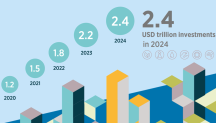

High-level Meeting in Luxembourg Takes Electromobility to Next Level
Newsletter
Electric vehicles can be a game-changer for renewable power and offer ideal opportunities for the broader introduction of renewables to the transport sector. Electric vehicles (EVs) create new demand for electricity that can be supplied by renewables. In addition to benefits like reducing CO2 emissions and air pollution, electric mobility could emerge as an important source of storage for variable sources of renewable electricity, so-called “batteries on wheels”.
Challenges and opportunities of electrified transport systems have now been discussed at a Ministerial Conference on Electromobility in Luxembourg. Supported by IRENA, Luxembourg organised a pentalateral conference 'Closing the loop between Energy and Transport' which for the first time ever gathered key stakeholders from all sectors involved such as car manufacturers, electricity market players and e-mobility actors. Energy and transport ministers, government representatives from the pentalateral region, CEOs and experts discussed strategies to accelerate the energy transition through electromobility.
With 730,000 EVs on the street in the Benelux, France and Germany today, the pentalateral region represents around 12 per cent of the global EVs fleet. By 2025, the fleet can grow to 4-5 million EVs. Participants highlighted the importance of policy measures and enabling frameworks for the roll-out of electromobility on the market. In the EU, particularly CO2 emission standards for cars supported the business case of EVs as ready-available option to comply with CO2 limit, provided e-cars are fueled with renewable. As a result of this incentivising policy frame, car manufacturers channeled the necessary investments towards the commercialisation of electric vehicle models, attendees widely agreed. Now concerns from consumers must need to be addressed like the cost of EVs in comparison to conventional cars, the disposal of batteries as well as driving range and charging infrastructure.
Participants continued to discuss the requirement of new charging infrastructure. With 123,000 public charging stations, the region has an insufficient ratio of cars/charging station of around 8:1. Decision makers would have to foresee a similar system like today’s petrol charging stations as the way ahead with charging in public urban locations like shopping malls and public parking lots. Yet, planning for public charging points fall behind the massive roll-out needed in the coming years.
Conference attendees also discussed electromobility in view of energy sector transition, so called smart charging. IRENA’s recent report “Innovation Outlook: Smart charging for electric vehicles” illustrates how an uncontrolled charging of EVs may exacerbate stress on distribution grids, resulting in large investment needs to reinforce the local grids. Adapting charging by dynamic pricing and digital technologies can reduce the investment needs for the uptake of EVs between 40 to 90 per cent, the report shows. Furthermore, benefits of so-called “batteries on wheels” can be maximised. By 2025, the car battery electricity storage capacity on the road may equal more than a third of the hourly nameplate generation capacity in pentalateral region.
Find out more about IRENA’s work on innovative solutions for a renewable-powered future.





